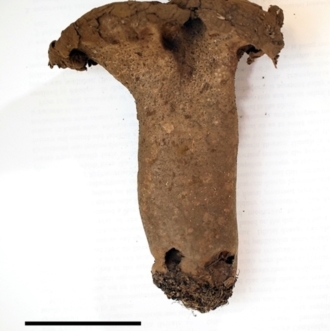Lycoperdon excipuliforme
The fruitbody is a puffball and consists of an enlarged, spore-bearing section atop a narrower, sterile base. The base is generally long relative to the upper section, thereby giving the puffball a pestle-like shape. They are often fairly large, up to about 15 cm tall (and 2-4 cm wide in the upper area), but larger examples occur. The young puffball is white and solid. The mature puffball is brown with the upper area containing powdery spores in a cottonwool-like mass of filaments and the lower area having a spongy feel (because, internally, it has numerous small cavities, like foam packaging).
The surface (in particular of the upper section) of the immature puffball bears slender spines and fine granules. The spines are in groups of 4-6 and within such a group the spines are joined at their apices. With age the spines may be eroded off (except perhaps for their bases).
At maturity the skin over the upper part opens irregularly and slowly breaks away to expose the spores for wind dispersal.
These puffballs are found on the ground in a variety of habitats, often in small groups.
Look-alikes
Lycoperdon perlatum has a similar shape but, at maturity, has a pockmarked/reticulate surface and the spines are simple. For more information see: https://canberra.naturemapr.org/species/47094
Lycoperdon excipuliforme is listed in the following regions:
Canberra & Southern Tablelands
Species information
- Lycoperdon excipuliforme Scientific name
- Common name
- Not Sensitive
- Cosmopolitan
- Non-invasive or negligible
- Machine learning







